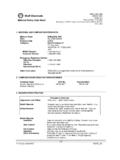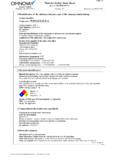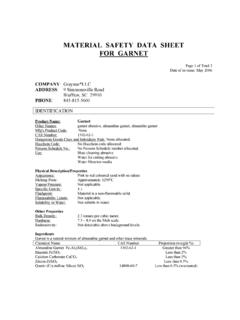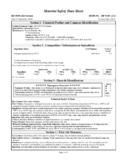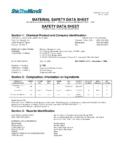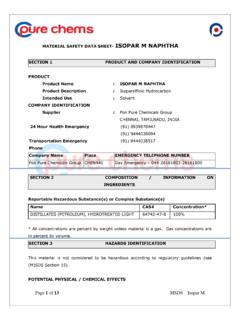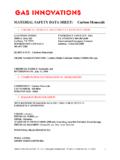Transcription of MATERIAL SAFETY DATA SHEET - Environmental …
1 MATERIAL SAFETY data SHEET . Prepared in accordance with OSHA Hazard communication Standard 29 CFR Section (g)(c)(1). Manufacturer's Name: Environmental Specialists Inc. Emergency Telephone Number 243 East Marshall Road **PERS (888) 633 8253**. McDonald, OH 44437 Information Telephone Number Date of Preparation: December 18, 2008 **(888) 331 3443**. SECTION 1: PRODUCT IDENTIFICATION. Product Name: On-Spec Used Oil Synonym: Used Oil, Used Oil Fuel, #4 Oil, Waste Oil Product Number: UO-001 Formula: Hydrocarbon mixture SECTION 2: COMPOSITION INFORMATION. Components CAS Number Weight %. Used Oils Mixture 80 100%. Water NA 0 20%. Diesel Fuel 68476-34-8 0 5%. Gasoline 6474-46-4 0 1%. Aromatic Hydrocarbons (solvents) NA 0 1%. Chlorinated Paraffins NA < Ethylene glycol NA Trace SECTION 3: HAZARDS IDENTIFICATION. Eye Contact: Not expected to cause prolonged or significant eye irritation.
2 Skin: Contact with the skin is not expected to cause prolonged or significant irritation or allergic skin response. This MATERIAL is not expected to be harmful to internal organs if absorbed thorough the skin. Ingestion: Not expected to be harmful if swallowed. Inhalation: Not expected to be harmful if inhaled. Contains petroleum-based mineral oil. May cause respiratory irritation or other pulmonary effects following prolonged or repeated inhalation of oil mist at airborne levels above the recommended mineral oil mist exposure limit. Symptoms of respiratory irritation may include coughing and difficulty breathing. Medical Pre-existing dermatitis may be aggravated. Conditions Aggravated: On-Spec Used Oil Page 1 of 7. ESI MSDS #001. Prepared 12/18/2008. MATERIAL SAFETY data SHEET . Prepared in accordance with OSHA Hazard communication Standard 29 CFR Section (g)(c)(1).
3 SECTION 4: FIRST AID MEASURES. Eye Contact: Flush eye immediately with fresh water. Remove contact lenses if worn. Eyelids should be held away from the eyeball to ensure thorough rinsing. This MATERIAL is not expected to cause prolonged or significant eye irritation. In the event irritation persists, seek medical attention. Skin: No specific first aid measures are required. As a precaution, remove clothing and shoes if contaminated. To remove MATERIAL from skin, use soap and water. Discard contaminated clothing and shoe or thoroughly clean before reuse. Ingestion: No specific first aid measure required. Do not induce vomiting. As a precaution get medical advice. Inhalation: No specific first aid measures are required. If exposed to excessive levels of MATERIAL in the air, move the exposed person to fresh air. Get medical attention if coughing or respiratory discomfort occurs.
4 SECTION 5: FIRE FIGHTING MEASURES. Flammable Properties: Not classified by OSHA as flammable or combustible MATERIAL . Flash Point: Tag Closed Cup = 210 F - 275 F. Flammable Limits: LEL Not Applicable UEL Not applicable Autoignition: No data available Hazardous Carbon dioxide, carbon monoxide, unburned hydrocarbons and oxides of Combustion Products: sulfur, zinc and/or nitrogen. Extinguishing Media: Use dry chemical, carbon dioxide, water fog, or foam to extinguish all fires. Fire Fighting This MATERIAL will burn although it is not easily ignited. For fires involving Instructions: this MATERIAL , do not enter any enclosed or confined fire space without proper protective equipment, including self-contained breathing apparatus. Use a smothering technique to extinguish a combustible liquid fire. Do not force water stream directly on oil fires, as this will scatter the fire.
5 Use a water fog to cool fire-exposed containers, structures, and to protect personnel. On-Spec Used Oil Page 2 of 7. ESI MSDS #001. Prepared 12/18/2008. MATERIAL SAFETY data SHEET . Prepared in accordance with OSHA Hazard communication Standard 29 CFR Section (g)(c)(1). SECTION 6: ACCIDENTIAL RELEASE MEASURES. Protective Measures: Eliminate all source of ignition in vicinity of spilled MATERIAL . Spill Management: Stop the source of the release if it can be done without risk. Contain release to prevent further contamination of soil, surface water or groundwater. DO. NOT flush down public sewers or other drainage systems. Place contaminated materials in appropriate containers and dispose of in accordance with local, state, and federal regulations. Store in a cool, dry, well-ventilated area away from heat, sources of ignition and incompatibles. Spill Reporting: The Clean Water Act requires the reporting of any discharge of oil or petroleum (in any form) into surface waters.
6 Immediately call the national Emergency Response Center at 1-800-424-8802. SECTION 7: HANDLING AND STORAGE. Handling: To avoid contamination of product keep containers closed when not in use. Empty containers retain product residues (solid, liquid, and/or vapor) that can be dangerous. Do not pressurize, cut, weld, braze, solder, drill, grind or expose containers to flames, sparks, heat or other potential ignitions sources. Empty containers should be completely drained, properly closed, and promptly returned to drum reconditioner or disposed of properly. Storage: Keep containers closed when not in use. Store in a cool, dry well-ventilated area. Do not store with strong oxidizing agents. Keep away from open flames and high temperatures. SECTION 8: EXPOSURE CONTROLS AND PERSONAL PROTECTION. Engineering Use in a well-ventilated area. Provide exhaust ventilation or other Controls: engineering controls to keep the airborne concentrations of mists and/or vapors below the recommended exposure limits (see below).
7 Have an eye wash station readily available where eye contact can occur. Personal Protective Personal protective equipment (PPE) selections vary based on the potential Equipment: exposure conditions such as handling practices, concentration and ventilation. At a minimum SAFETY glasses and skin protection should be worn. Additional PPE may be required based on specific working conditions. Eye Protection: SAFETY glasses equipped with side shields are recommended for minimal protection. Wear goggles if splashing or spraying for added protection in the event splashing or spraying is expected. Hand Protection: Incidental contact with oil does not require hand protection. If frequent or prolonged exposure is expected chemical resistant gloves should be worn. Gloves should be nitrile, neoprene, or vinyl. On-Spec Used Oil Page 3 of 7. ESI MSDS #001. Prepared 12/18/2008.
8 MATERIAL SAFETY data SHEET . Prepared in accordance with OSHA Hazard communication Standard 29 CFR Section (g)(c)(1). Skin Protection: Uniforms or coveralls should provide adequate protection under normal working conditions. If prolonged contact is unavoidable, wear protective clothing made of polyvinyl alcohol (PVA), polyvinyl chloride (PVC), neoprene, or nitrile. Remove oil contaminated clothing and launder before reuse. Heavily contaminate clothing and leather goods should be removed promptly and cleaned or discarded. Respiratory Under normal use, respiratory protection is not required. If the Protection: engineering controls do not maintain airborne concentrations at a level which is adequate to protect the health of the employee, a NIOSH-approved organic vapor respirator equipped with a dust/mist prefilter should be worn. Respirator selection, use, and maintenance should be in accordance with the requirements of the OSHA Respiratory Protection Standard, 29 CFR Occupational Exposure Guidelines: Substance Applicable Workplace Exposure Levels ACGIH OSHA.
9 3 3. Oil Mist, Mineral TWA: 5 mg/m TWA: 5 mg/m 3. STEL: 10 mg/m 3 3. Diesel Fuel Mist TWA: 5 mg/m TWA: 5 mg/m 3. STEL: 10 mg/m Gasoline TWA: 300 ppm NE. STEL: NE. NE = Not Established SECTION 9: PHYSICAL AND CHEMICAL PROPERTIES. Color: Light brown to black Physical State: Liquid Odor: Mild petroleum hydrocarbon Vapor Pressure: <0. 1 mmHg @ 68 F. pH: NA Vapor Density > (H2O = 1). Boiling Point: 180 220 F Solubility: Insoluble in water Freezing Point: NA Specific Gravity: (H2O = 1). SECTION 10: STABILITY AND REACTIVITY. Chemical Stability: Stable Hazardous Not expected to occur. Polymerization: Conditions to Avoid: Keep away form extreme heat, sparks, open flames, and strong oxidizers. On-Spec Used Oil Page 4 of 7. ESI MSDS #001. Prepared 12/18/2008. MATERIAL SAFETY data SHEET . Prepared in accordance with OSHA Hazard communication Standard 29 CFR Section (g)(c)(1).
10 Incompatibility with May react with strong acids or strong oxidizing agents such as chlorates, Other Materials: nitrates, peroxides, etc. Hazardous No additional hazardous decomposition products other than those identified in Decomposition Section 5 of this MSDS. Products: SECTION 11: TOXICOLOGICAL INFORMATION. Acute Symptoms of Exposure: Inhalation: High concentrations of aerosol or mist may be generated at high temperatures and may be irritating to the respiratory tract, including nose and throat, and may cause difficulty breathing. This may be particularly true with people who have a high level of sensitivity and allergic reactions. Ingestion: May cause mild irritation of the digestive tract, including cramping, diarrhea, nausea, and vomiting. Aspiration into the lungs by initial ingestion or vomiting may cause mild to severe pulmonary injury. Skin: Prolongs and/or repeated exposure may cause mil skin irritation, including redness, burning, temporary drying/cracking, and acute dermatitis.
